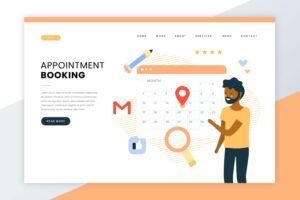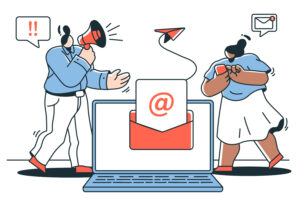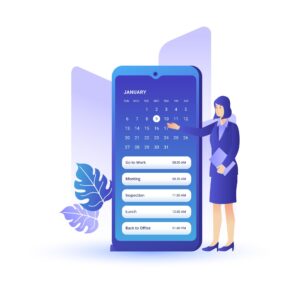Let’s learn how you can improve your site’s conversion rate and increase online bookings!
If you’re dependent on online bookings to keep your business running, you’re probably spending a lot of time driving traffic to your website – be it SEO, social media, ad campaigns, PR, or any other strategies.
However, you know that driving visitors to your website is only the tip of the iceberg. The real deal is getting these visitors to actually make a booking – that is get your visitors to convert.
Luckily, there are a set of tried-and-tested tactics to make sure your visitors convert and these tactics are broadly referred to as conversion rate optimization or CRO. The process starts with optimizing the quality of your traffic, and goes all the way to fine-tuning your design and making sure booking page abandoners are attracted again.
Let’s get into the details of how you can use CRO to increase the number of bookings from your traffic.
Why CRO Matters for Online Bookings?
Conversion rate is an important metric for all businesses. It carries extra weight if you have an online booking system. You may get tons of traffic to your website, but it won’t translate into revenue if you have a low conversion rate.
Conversion rate is the percentage of people who complete a desired action out of all website visitors. In this case, we want website visitors to complete a booking. So optimizing your conversion rate equals more bookings and revenue.
7 CRO Tactics to Increase Your Online Bookings
In the most simplistic way imaginable, a working conversion rate optimization (CRO) strategy focuses on three things:
- Understanding an audience’s search intent.
- Driving traffic via well-targeted content.
- Offering a seamless experience that’ll be crucial in visitors’ decision-making processes.
Search intent is what people have in mind when they search something online. Say someone searches for the keyword “beauty salons in London”. They most probably don’t know anything about beauty salons in London yet and are still gathering information. What they’re hoping to find is a list of beauty salons in London with a comparison between their services and prices. The kind of content you’re producing for this keyword should provide them with exactly this information.
Targeted content speaks to your audience and helps them achieve their purposes. In our example, it’s not a good idea to produce a price page with your services for that keyword.
Experience refers to many things. Your marketing material, pricing, the design and the elements of your website, your brand’s identity and values, and much more.
These characteristics come together to create the experience people have with your brand. And there are various CRO tools and tactics to help you get more online bookings and refine the experience to meet your audience’s expectations.
- Get to know your audience
- Optimize your booking page
- Offer online payment options
- Offer a transparent pricing structure
- Collect and display customer reviews
- Use remarketing to motivate booking page abandoners
- Increase customer lifetime value
1. Get to know your audience
To meet your target audience’s expectations, you have to grow closer to them. You must have a deep understanding of their interests and needs.
One mistake small businesses often make regarding this is underestimating their data analytics capabilities. Regardless of your business size, you have access to valuable customer data. The problem usually comes from its isolation.
All the systems you use store valuable information about customers and prospects. Email software, payment system, CRM, Google Search Console, reservation software, sales software, and many other tools collect valuable data.
Connect software you use to bring together all the information you have on customers. This way you can have a holistic understanding of your audience’s characteristics and behavior.
You can, for instance, measure how well an email campaign translates into bookings. All you have to do is to combine data from email marketing software and booking software. This way, you can offer tailored messaging and experiences that’ll increase bookings. And it’s not the only benefit.
If you uphold your audience’s high standards, you’ll build a strong relationship with them. People will get used to coming to you for a seamless experience. They will gradually develop a sense of belonging to your business.
2. Optimize your booking page
A well-designed booking page successfully grabs a visitor’s attention and holds on to it until they complete a booking. It informs visitors about a business’s services, and it does so in an engaging way.
Optimize your booking website in a way that’ll best appeal to your target audience. Make sure it lays out detailed information about your services and mentions what makes you different in terms of service quality, speed, price, and other areas.
If you need customer details for a booking, use a booking form to collect it on the booking page. It’ll ease the booking process, which is a great way to improve your conversion rate.
Keep in mind, there will always be room for growth. You have to continuously invest some of your time and resources into:
- Monitoring important website metrics and customer data.
- Gaining insights into your audience’s behavior.
- Optimizing your website accordingly.
Luckily, technology is here to help. Many business management platforms offer analytics modules that are pretty easy to use.
You can also use a heat map to observe the behavior of website visitors. Heat maps are tools that track how visitors interact with your website. Product insights tools or CRO tools like Hotjar record visitors’ sessions so that you can watch exactly how they interact with your website.
3. Offer online payment options
A 2022 McKinsey research found that nearly 90% of US consumers are using some form of digital payment. And over 60% of Americans report that they use two or more. This is a growing trend across industries.
If you want your business to be future-ready, offer customers seamless payment options. Payment gateways such as PayPal and Stripe help you secure payments via your booking page. These tools are huge time-savers for your staff. But more importantly, they make life easier for your customers. Customers don’t need to enter credit card information every time they want to book your service. They simply enter, say, their PayPal password, and it’s done!
You can also accept small deposit payments if you don’t want to charge customers before the appointment takes place. Deposits can work as an encouragement for your customers to show up, and as a small compensation if they don’t.
4. Offer a transparent pricing structure
A 2023 study revealed that 71% of global customers do price searching before they make a buying decision. While this behavior mainly exists among retail consumers, it’s about to take over all industries.
Consumers are increasingly savvy. They are growing better at using price comparison tools and price drop alerts to get good deals. The smartest way to appeal to this price-sensitive audience is to offer transparent pricing. What does this mean?
When someone looks for pricing information, they should easily access it. You can add pricing information to your booking page, or create a standalone pricing page. Wherever you display them on your website, your pricing plans should communicate the value of your services.
If you offer excellent customer service, for instance, consider this as a feature and mention this in the pricing plan. You might say, is a quality like this even worth mentioning? Yes. People don’t automatically assume that your business has top-notch service quality. Talking about this in your pricing plans makes it a part of the deal customers get. It shows that you trust your organization to deliver great experiences.
5. Collect and display customer reviews
In Brightlocal’s 2023 Local Consumer Study, 98% of consumers say they read and leave local business reviews. And nearly 46% trust online reviews as much as they trust recommendations from friends and family.
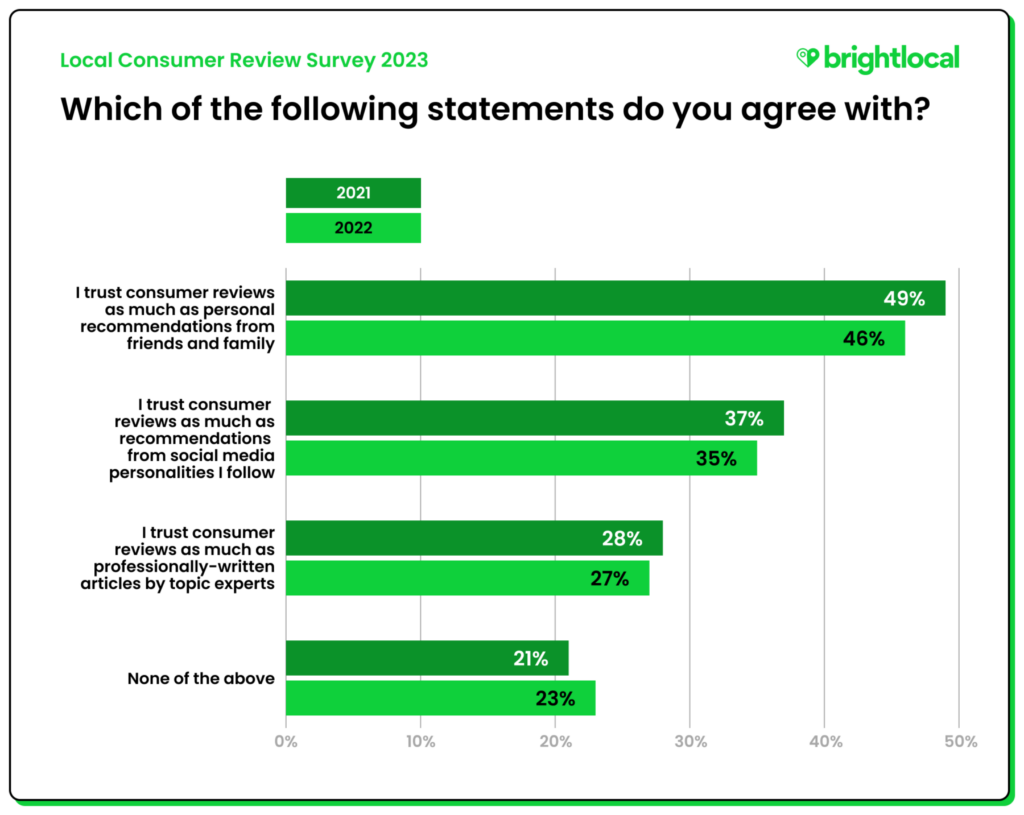
Reviews function as social proof, and come very handy in building trust with your audience. When customers are happy about your service, ask them if they could leave an online review. Reviews not only encourage website visitors to trust you, but they also show that you care about your existing customers’ opinions and feelings about your business.
You can also use incentives for customers to write reviews. A small gift or discount could work as a perfect incentive. And these kinds of small gestures can also be a part of your loyalty program.
Encourage customers to refer you to their friends, family, or peers. When they bring new customers, reward them with special perks and discounts – like a one-time free appointment, a branded gift box, or a discount coupon for the next appointment.
You also need to make sure the reviews you get from customers have an effective structure. Here are some details you need to keep in mind when it comes to positive reviews:
- Describe customer experience in detail rather than general terms.
- Add photos and videos if possible.
- Mention team members or location if applicable (useful for service businesses).
- Mention a customer’s long-term association with you.
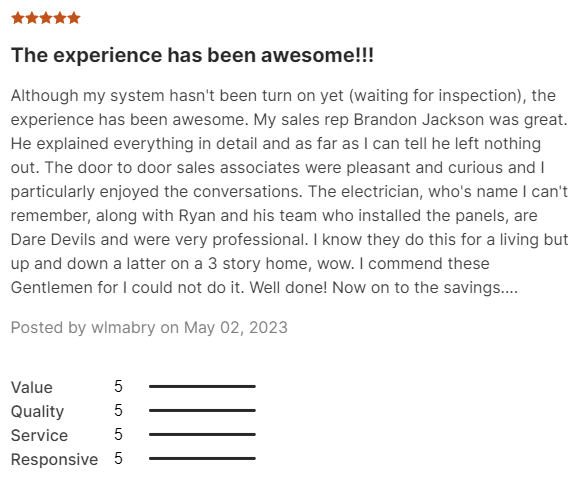
Once people start leaving reviews, display them on your homepage and booking page. You can share them on your social accounts as well. Customer loyalty software tools make it extremely easy to collaborate with customers and elicit timely reviews from them.
6. Use remarketing to motivate booking page abandoners
It usually takes time for people to get familiar with a brand. When new users first land on your website, it’s likely that they don’t know much about your business. New users often need to have several interactions with a brand until they feel like they can trust it. You can always wait for them to initiate those interactions, say, by visiting again. But there’s a better way – remarketing.
Remarketing is basically serving ads and content to people who visited your website but didn’t make a booking. Your remarketing audience is the people who have at least some level of awareness around your brand and services. These people are more likely to convert to customers in comparison with random internet users who have not visited your website yet. So it’s smart to spare some of your advertising budget to remarketing campaigns.
Paid advertising platforms like Google Ads already have remarketing features. You can simply choose which ad will be shown to whom. Sending personalized follow-up emails is also a great CRO tactic to convert page abandoners.
7. Increase customer lifetime value
Customer lifetime value (CLV) is the net amount of profit you can make from your customers throughout their relationship with you. This could be in the form of increasing the value of their one-time bookings or prompting them to make multiple bookings.
The most important step here is providing a great customer experience in the first place so customers would be happy to do more business with you. Customers who make repeat purchases are more valuable in the long run.
You can also increase the value of the bookings by offering discounts for multiple bookings or offering cross-selling opportunities. For example, you can offer a 10% discount on the final price if someone makes a booking for more than 3 people or if they make some bookings for the upcoming months. Or, if you’re a hairdresser, you might offer multiple services in a package such as shampooing, cutting, coloring, styling, hair accessories, or even more professional services such as scalp treatment, hair volumizing, etc.
Finally: CRO Is a Long Game
If you read so far, you have an understanding of what influences conversion rates, and how to improve yours. The CRO tactics we went over might sound complicated at first, but today’s technologies are incredibly intuitive. And you don’t have to rush anything – CRO is a long game.
It’s always smart to test new and different communication, marketing, and sales strategies. Even rebranding is not a bad strategy if it gets you closer to your audience. You need to keep up with how your audience and your market evolve and always test strategies that cater to their interests and needs.

